Ask a question from expert
OENG1089 - Graphene Oxide Membrane
36 Pages10599 Words421 Views
Added on 2019-10-31
OENG1089 - Graphene Oxide Membrane
Added on 2019-10-31
BookmarkShareRelated Documents
Running Head: GRAPHENE OXIDE MEMBRANEGraphene Oxide MembraneStudent’s name:Institution Affiliation:
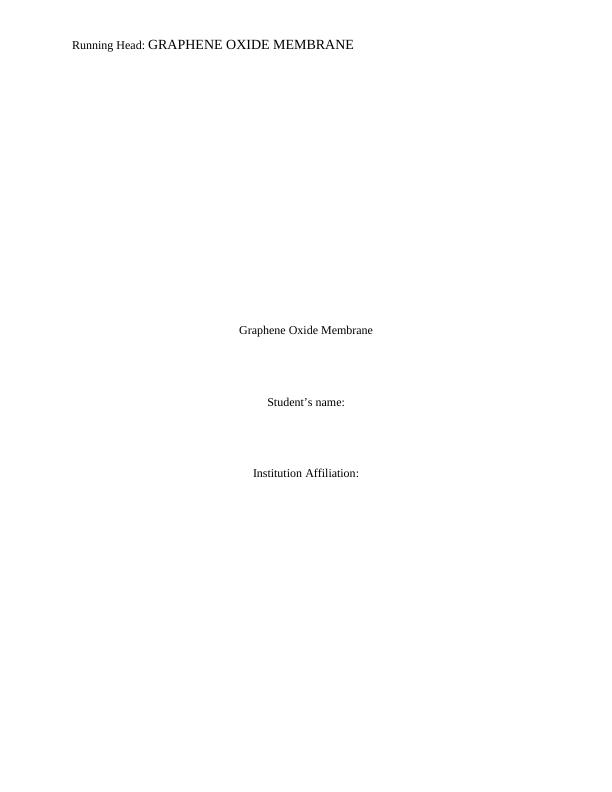
Table of Contents1.0 Introduction to Graphene Oxide membrane and water desalination.........................................21.1 Freestanding Graphene Oxide membrane..............................................................................21.2 Graphene Oxide for membrane surface modification............................................................31.3 GO-consolidated composite layer..........................................................................................41.4 How commercially Graphene oxide is made.........................................................................52.0 Materials and Methods..............................................................................................................82.1 Graphene Oxide Properties....................................................................................................82.2 Graphene Oxide synthesis by using modified Hummers method..........................................92.3 Introduction about vacuum filtration process......................................................................122.4 Reduced Graphene oxide membrane...................................................................................132.5 How reduced Graphene oxide membrane is more useful than Graphene oxidemembrane142.6 Vacuum filtration process and fabrication of Graphene oxide membrane from vacuum filtration......................................................................................................................................152.7 Reduction of water content from Graphene oxide solution by using hydrogel beads.........173.0 Characterization of GO flakes by using AFM, SEM and Raman Spectroscopy.....................193.1 Characterization of Graphene Oxide by using AFM...........................................................193.2 Characterization of GO by using SEM................................................................................213.3 Characterization of GO by using Raman spectroscopy.......................................................234.0 Permeation Experiments by using forward osmosis (FO) process (FO Apparatus)................254.1 Forward osmosis..................................................................................................................264.2 How Graphene Oxide membrane can be used in FO process..............................................284.3 Results..................................................................................................................................294.4 Conclusion...........................................................................................................................295.0 References................................................................................................................................30

1.0 Introduction to Graphene Oxide membrane and water desalinationGraphene oxide is a mono layer form of graphite. Graphite Oxide is a compound of oxygen, hydrogen, and carbon. Graphite oxide is obtained from graphite when it’s treated with strong oxidizing agents.Graphene Oxide sheets have been primarily applied to make thin films, composite materials, and Graphene membranes.Originally, Graphene Oxide had appealed to manufacturers for use as an intermediate in the making of Graphene. The reduction of Graphene Oxide to come up with Graphene gave out Graphene that had many defects both structurally and chemically. This is a significant problem to some of the areas of application of Graphene while it is advantageous to some other uses.In the creation of desalination layers, Graphene Oxide could conceivably be connected to detached layers, on the surface of layers or through fused threw films. The principal strategy usesGraphene Oxide as an isolating layer specifically, the second utilizes Graphene Oxide for film surface alteration, and in the third method, Graphene Oxide is consolidated into a polymer framework (Nan, Li, & Cao, 2016). The following three methods have been used to manufacture purification sheaths:1.1 Freestanding Graphene Oxide membraneDifferent systems were connected to manufacture unattached GO layers with gaps among GO nanosheets by utilizing the relentless vacuum filtration technique proclaimed by Xu et al. This social event has made GO/TiO2 composite NF film with a standard pore size of 3.5 nm by displaying TiO2 nanoparticles between GO nanosheets to develop the openings and edge channels. The NF GO/TiO2 film has completed 100percent dismissal of Rhodamine B (RB) and
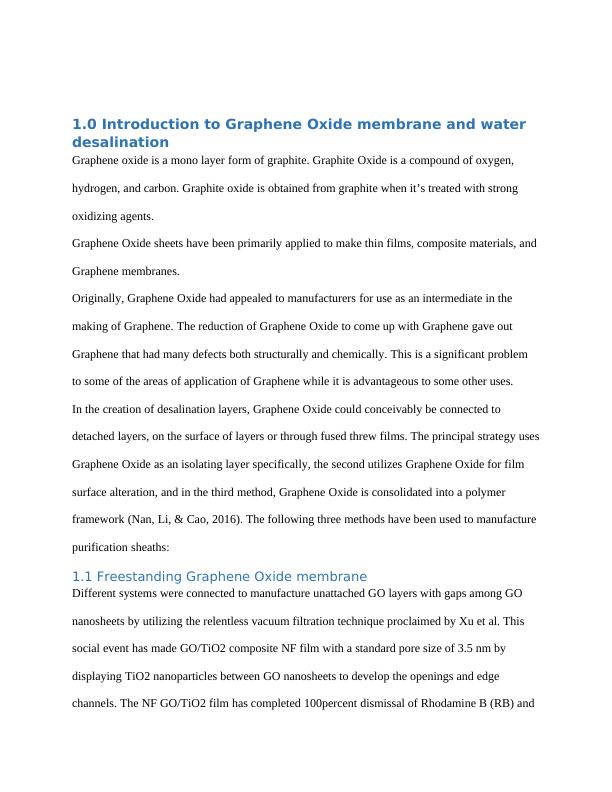
methyl orange (MO) from the water. In a substitute report, by Nair et al., the intersheet openings were restricted to 1 nm. The examiners produced the unsupported Cu-went NF layers through a sprinkle or turn covering system, which utilized the stable scattered GO/water respond in due order regarding make more overlays among GO nanosheets. The got layers were entirely impervious to gasses, vapors, and fluids and additionally helium; notwithstanding, these manufactured layers allowed unlimited water saturation. Furthermore, the water saturates over the manufactured films at around 1010 times quicker than helium. Sun et al. manufactured GO unattached NF films by means of a drop-throwing method, which lessened the intersheet dividing to 0.82 nm. The acquired layers were connected to proficiently separate sodium briny from natural pollutants and copper salt. As of late, Nicolaï׳s gather provided details regarding their utilization of sub-atomic progression reenactments (MDS), that unattached GO layers are remarkable possibility for RO film applications to acknowledge capable water desalination. Unsupported GO films can dismiss salt by 100percent, while at the same time permitting brilliantwater penetration, with twofold the pervasion capacity of ebb and flow RO methods in view of the GO membranes׳ultrathin thickness1.2 Graphene Oxide for membrane surface modificationLayer surface change using GO could overhaul a couple of film properties, including the antimicrobial effect, which is liberally upgraded when GO on the layer surface partners clearly with the bacterial cells. Additionally, the GO-adjusted layers are more chlorine safe while keeping up a similar RO execution. Further, surface adjustment requires generally little amounts of nanomaterial (GO), influencing it to financially savvy and limiting the ecological effects caused by GO creation.
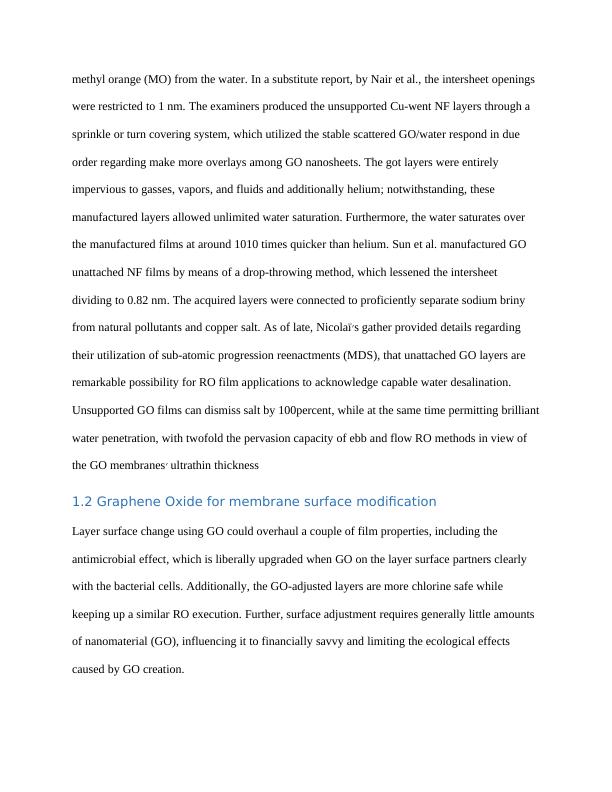
The effect of GO modification on layer antibacterial properties was additionally analyzed by Perreault et al. This work revealed the primary arrangement to covalently append GO nanosheetsto the surface of PA (TFC) films for antimicrobial purposes. The GO nanosheets had a covalent bond with the PA thin layer. The altered film showed proficient inactivation of the bacterial cellsby 65percent following 60 minutes, without giving up water motion and salt dismissal. Additionally, it was watched that the balanced layers ended up being more hydrophilic, which was confirmed by the diminishing of the water contact point from 81° for the control film to 47° for the changed layers, inferable from the surface oxygen functionalities of Graphene Oxide (Arubaito, 2012). The GO-surface balanced layers were utilized successfully as pervaporation layers. The investigators asked for versatile multilayers of GO on the surface of balanced polyacrylonitrile (PAN) films using the weight helped self-social gathering strategy. The got composite layer indicated excellent execution: approximately 99.5 wtpercent water recovery and 4137 g/m2 h water infiltration movement in the midst of the pervaporation parcel test, using 70 wtpercent isopropyl alcohol (IPA)/water arrangement. The critical selectivity was credited to the saved thick Graphene Oxide covers, which were pressed in idealize arrange, allowing just water and dodging saturation of IPA particles. 1.3 GO-consolidated composite layer As of late, analysts have concentrated on adding GO to polymer combined answers for be thrownto enhance water porousness, antimicrobial properties, and mechanical quality. GO can either be pre-functionalised before incorporation in the polymer lattice or connected without functionalization. The primary procedure was utilized by a few specialists. GO was functionalized by various modifiers: hyper-fanned polyethyleneimine (HPEI), three-amino propyl triethoxy silane (APTS)
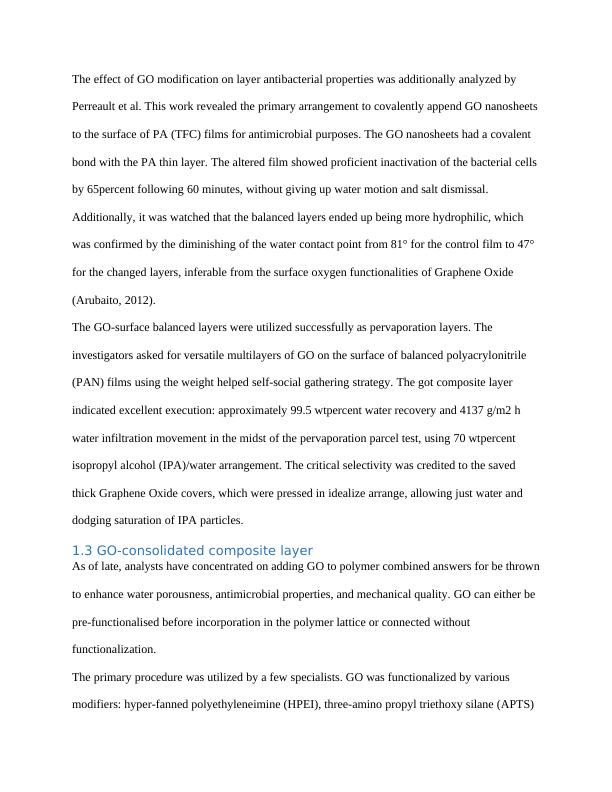
and isocyanate (I). Assorted degrees of functionalized GO (f-GO) were then blended with polymer strategies, i.e., polyvinylidene fluoride (PVDF) and polysulfone (PSF)individually to betossed by the typical stage inversion technique. The got made ultrafiltration layers (APTS f-GO/PVDF and I-f-GO/PSF) could remove dairy creatures like serum egg whites (BSA) by 57 percentand 95 percent autonomously, while the HPEI-GO/PSF declined PEG 20,000 by 85percent and polyvinyl alcohol (PVA) 30,000– 70,000 by 90percent. Xu et al. revealed that the mechanical properties (stretching at-break and flexibility) of APTS f-GO/PVDF layers were improved by 48.38percent and 69.01percent separately appeared differently in relation to GO/PVDF layers in light of the strong interfacial reaction between APTS f-Graphene Oxide and the polymer cross section. A comparable example was found by Yu et al., who declared that the HPEI f-GO/PSF film exhibited through and through better Young׳s modulus and unbending nature. Further, the antifouling properties of the produced layers were adequately improved by including f-Graphene Oxide, overhauling the hydrophilic properties of the layers and giving extra negative charge, which was affirm by zeta potential estimation and smooth film surface geography. Another functionalized Graphene Oxide layer was created by presenting the Graphene Oxide with polyelectrolyte buildings (PECs). Polyethyleneimine (PEI)- adjusted Graphene Oxide, and polyacrylic corrosive (PAA) were kept successively on the surface of a hydrolyzed PAN ultrafiltration film substrate. The nanohybrid layer was plunged in PVA arrangements and afterward cross-connected by means of glutaraldehyde. Nanohybrid GO/PECs films can evacuate color atoms. The dismissal of Congo red (CR) accomplished 99.5 percent, and the water penetrability was 8.4 kg/m2 h MPa. For the dismissal of monovalent and divalent particles,such films showed great NF qualities. The dismissal of Na+ and Mg2+ were 43.2percent and 92.6 percent separately.

1.4 How commercially Graphene oxide is madeGraphene oxide is an improved kind of Graphene that has been managed to outline oxide-based materials. It is conveyed by the oxidation of graphite and coming about peeling, molding a flawed, yet useful, cross segment. Oxidation treatment, generally, incorporates reactions in acids or start. The most typically recognized oxidation treatment comprises of a substance method, using a sulfuric corrosive, sodium nitrate, and potassium permanganate mix, called the Hummer's technique; be that as it may, different strategies promising a complete oxidation have been created. Oxidation of the graphite enormously enhances the peeling procedure, which is the reason GO tends to be considerably less costly than Graphene (Griggs, C.S. & Medina, Victor, 2016).The concoction peeling of GTO is the great technique for getting GO. GO is delivered by means of either the Brodie, Staudenmaier or Hummers route or by methods for various changes of theseframeworks (for example, the Hummers adjusted process), allowing colossal measures of epoxy, hydroxyl and carboxylic social events in the subsequent graphene. The significantly oxidized graphene orchestrated by this procedure is commonly known as Graphene Oxide. The methods fuse graphite oxidation to genuine levels. Brodie and Staudenmaier oxidize the graphite using a mix of nitric destructive (HNO3) and potassium chlorate (KClO3); on the other hand, the Hummers system oxidizes the graphite utilizing a blend of potassium permanganate (KMnO4) and sulphuric destructive (H2SO4). The gained graphite salts organized by methods for intercalating graphite with strong acids, i.e., H2SO4, HNO3 or HClO4 are made before the oxidation of graphite and, finally, the shedding of GO in water, to get GO nanosheets.
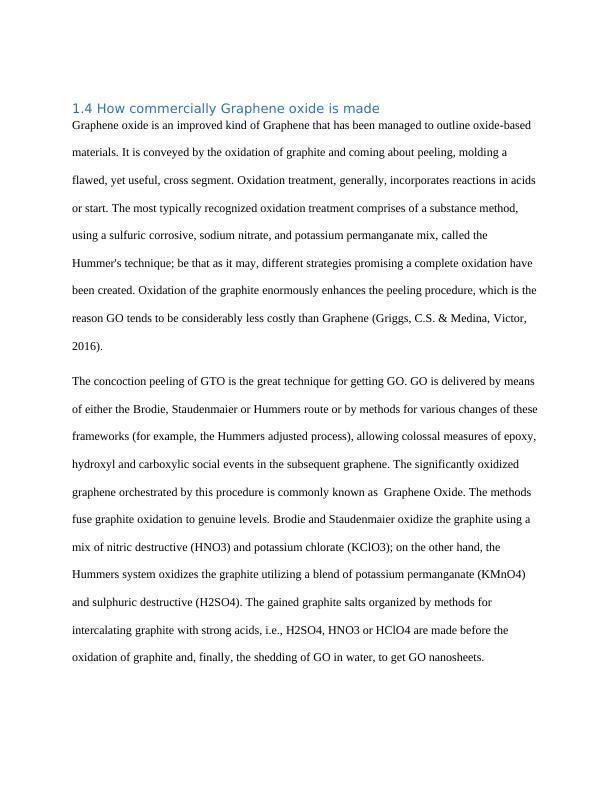
The GO could be lessened to graphene by hydrazine vapor; be that as it may, the decreased graphene sheets tend to shape overwhelming totals and hasten from the response medium on the grounds that the recouped graphite area builds their hydrophobicity and identifies with stacking associations. This issue can be overpowered by familiarizing sulphonic utilitarian social affairs with the surface of to some degree reduced GO. The conflictingly charged units can enough keepthe graphene sheets from conglomerating. GO could be covalently changed by methods for the amination coupling of carboxylic or epoxy social affairs, or non-covalently functionalized. Moreover, some astounding properties of adjusted Have been dissected, i.e., optical qualities conferred by pH, biocompatibility for L-929 cells increase and bond, water-insoluble prescription transport property and high antibacterial activity.2.0 Materials and Methods2.1 Graphene Oxide Properties Due to the closeness of oxygen functionalities, Graphene oxide can without a considerable measure of an expand scatter in like manner solvents, water, and differing structures. This is a basic ideal position when joining the material with polymer or breathtaking frameworks to upgrade their mechanical and electrical properties. Concerning electrical conductivity, Graphene oxide fills in as an electrical safeguard, in light of the disturbance of its sp2 holding structures. It is principal to diminish the Graphene oxide to recoup the honeycomb hexagonal cross fragment of Graphene, with a specific genuine target to reestablish electrical conductivity.
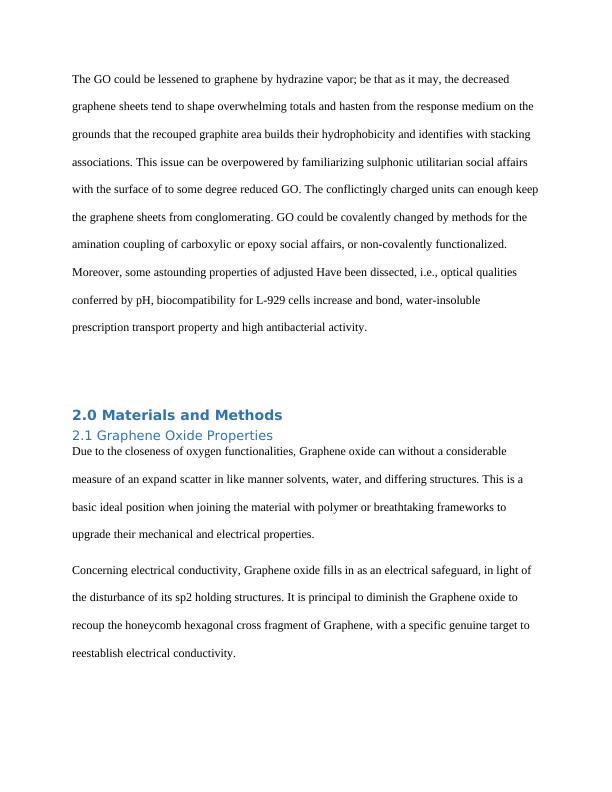
End of preview
Want to access all the pages? Upload your documents or become a member.